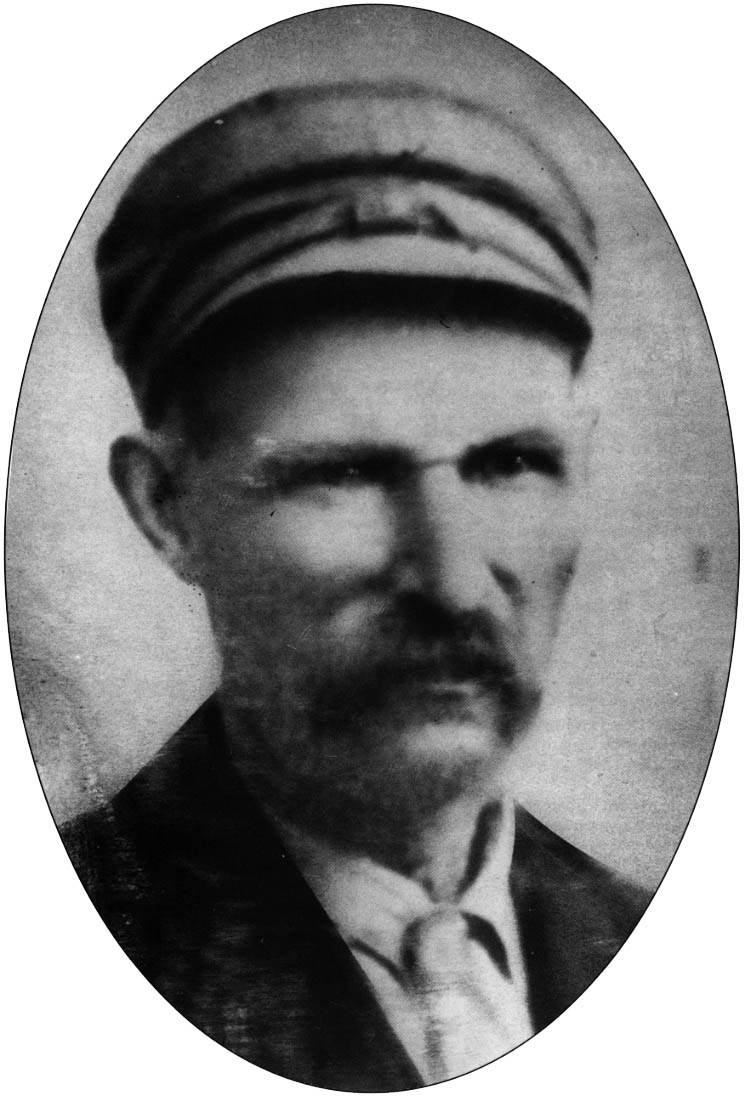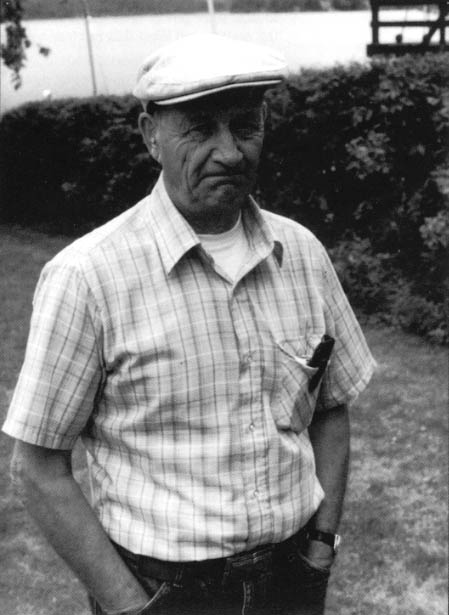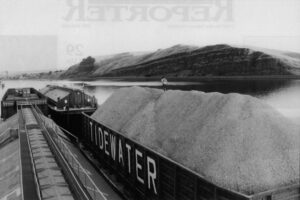Arno Harden sneaked aboard a boxcar in Great Falls, Montana, in the late summer of 1932. He was twenty-one, fresh out of work, alone, and heading West. Everything he owned he carried with him. He had a bedroll and a pillowcase half-stuffed with clothes and one pair of shoes, the work boots on his feet. He wore a plaid wool mackinaw and a black cap with flannel earflaps. Two months of bucking hay for a Great Falls farmer who let him sleep in the granary had earned him $80. The money was in his pocket, along with a sandwich he bought in a rail-yard cafe. My father also carried a letter — from his father.

The letter told him not to come home. It said there was nothing at the family farm in northeast Montana to come home for. His mother had died in the spring, of liver cancer at the age of forty. Drought had ruined the three-hundred and sixty-acre farm that his father leased from a New York City banker. Crops of wheat, barley, and corn had failed, and topsoil was beginning to blow. The livestock had no feed for winter, and two-thousand, five-hundred head of sheep, sixty cattle, and twenty-five horses were being sold at one third the price of 1929.
The letter instructed my father, the oldest of eight children, to find his way out to Washington State. There was a chance that Joe Harden, an uncle who worked in an apple processing town called Wenatchee, might know of a job. It was understood that my grandfather, as soon as he could collect on the livestock, would load the rest of the family in a four-year- old Oldsmobile and follow my father west.
For the third time in three decades, the Hardens had bet on rain in a dry country and lost.

When my father hopped the boxcar in Great Falls, he broke the family’s dismal cycle of westering dreams, dry-land failure, and bankrupt flight. The boxcar dropped Arno Harden off in a radically different version of the American West. In this version, the harsh edges of an arid land were engineered away.
Uncle Joe, as hoped, came through with a job when my father arrived in Washington State. He went right to work at Columbia Ice & Cold Storage, wrestling one-hundred-and-fifty pound cakes of ice into boxcars packed with apples. We worked in a rail yard down beside the most intimidating river he had ever seen.
The two keys to the engineered West that my family came to inhabit are that huge, cold, swift-flowing river and the federal government’s zealous desire to milk it for power.
Size is not the most meaningful measure of the Columbia River. It is, of course, big: 1,214 miles long and nearly ten miles wide as it nears the sea. Snaking south out of the Canadian Rockies and flowing west to the Pacific, it drains an area larger than the Eastern seaboard from Maine to Virginia. Its annual discharge would spread a foot of water across all of California and Arizona. There are three bigger rivers in North America. The Mississippi, the Mackenzie, and the St. Lawrence all travel farther and discharge more water. But none of them compare to the Columbia for power.
For a principal river of the world, it has an astoundingly steep drop. It falls nearly twice as far as the Mississippi — in about half the distance. In Washington State alone, it drops a thousand feet while traveling less than 400 miles. The Mississippi, by comparison, drops only 100 feet in the 700 miles between St. Louis and the Gulf of Mexico. The greater a river’s drop, the greater its power and the greater its capacity to arouse the builders of dams. Every half hour the Columbia expends as much energy as was released by the explosion of the Hiroshima bomb.
“It can truly be described as the greatest natural resource in the United States west of the Rocky Mountain,” the Bureau of Reclamation, the federal agency that built most dams in the West, gushed in the year after my father arrived in Wenatchee. No river the size of the Columbia had been dammed anywhere in the world. But the potential pay-off was irresistible. The river and its tributaries embodied a third of the hydroelectric potential of the entire United States.
The Great Depression that had forced my father and three- quarters of a million paupers to migrate West to Washington, Oregon, and California was also forcing the federal government to dream up some kind of work for all these wanderers to do. The answer that President Franklin D. Roosevelt (the only president my father ever loved) came up with was dams. Huge dams, lots of huge dams, more huge dams built by one government at the same time than ever before in world history. By the mid-thirties, the four largest concrete dams ever built were going up in the West. Two of them, including Grand Coulee, still the biggest dam in North America, were on the Columbia River. In the next forty years, as the Columbia was transformed from America’s largest free-flowing stream into a slackwater plumbing system, there would be eleven more big dams on the mainstem of the Columbia and hundreds more on its tributaries.
The engineered West offered a superior brand of life, particularly in its far northwest corner, where the most powerful river was bottled by the biggest dams. Dams gave the Pacific Northwest the cheapest and most abundant electricity in the country. They turned the deserts of eastern Washington and Oregon into gardens. Their power made aluminum for the airplanes and fuel for the atomic bombs that won World War II. Their locks performed the amazing feat of turning a town in Idaho into a major seaport four-hundred and sixty-five miles from the sea. The Bureau of Reclamation summed up what it was doing in the Columbia Basin with the official slogan, “Our Rivers: Total Use for Greater Wealth.”
My father got a piece of the greater wealth by working at Grand Coulee, when it was built in the 1930s and when it was expanded in the 1970s. He also worked at Wanapum Dam on the Columbia, and at Hanford Atomic Works, which was built beside the river.
The family’s bankruptcy back in 1932 was nobody’s fault. It came after the longest severe drought in American history and a worldwide collapse in farm prices. Before the Great Depression, the Harden farm near the Montana village of Glentana had been a sound investment, making money and feeding children.

But the failure thirteen years earlier of another Harden farm in eastern Montana stemmed from their own credulity. It was a common weakness of the westering sodbuster. My great- grandfather, Elvin Eldorado Harden, and his seven adult sons and two daughters, allowed themselves to believe fanciful railroad advertisements about fertile free land at the railhead. A westering instinct had brought Eldorado west to the Dakotas from Iowa at the turn of the century. Having failed to make a go of farming in a North Dakota town called Bowbells, that instinct again was eating at Eldorado in 1914. Ignoring warnings from Dakota neighbors who said he would go broke and starve, he and his sons smelled success in Montana and believed rain would follow the plow.
Weather conspired with the railroads to trick the Hardens, along with more than 100,000 settlers who rolled into Montana in the first eighteen years of the century. It was deceitfully wet in eastern Montana during those years, with showers falling at just the right time for bumper crops of wheat. One of Eldorado’s sons, my great-uncle Claude, who dictated memoirs before his death, described the family’s arrival on the homesteads. “The weather was real nice. The grass was green, birds were around singing. We all [Eldorado and each of his sons] got a half- section [320 acres]. The land all joined. It really laid nice, grass to the horses’ knees.”
Once that grass around the homesteads was eaten by livestock, it did not grow back. The ground never produced a decent crop, even with good rain. It was infertile — black- cotton gumbo and alkali. And the rains petered out two years after the Hardens arrived. Drought struck in 1919, which still stands as the most catastrophic year in the history of Montana farming. There were plagues of cutworms, grasshoppers, and gophers. Great forest fires raged out of control in the western woodlands, and dust storms shrouded the east. In a year when sixty thousand farmers gave up on Montana, Eldorado, then sixty- one years old, convinced his boys to stick it out. He told my great-aunt Pauline, “Let’s stay another year. Maybe it will rain.”
Eldorado died that year in his sod house of a misdiagnosed bowel obstruction, and his boys scattered, most of them north to Canada. Some of them, including my grandfather, filtered back to better land in Montana in the 1920s, only to be seduced by more good rain and set up for the Great Drought.
The Hardens perceived no pattern of failure. Optimism blossomed with each new piece of land. And the interlude of prosperity before the Depression allowed my father to come of age in a version of the West where myths about individualism had a grounding in fact. My father broke wild horses, hauled lignite coal in an open wagon through prairie blizzards, took lickings from a father who was quick with the razor strap, and he boxed every Sunday with his relatives and neighbors. He even slept handcuffed to a horse thief named Star Nash.
Star Nash stole two horses, saddles, blankets, and silver spurs from a farmer near Malta, Montana, and rode north toward Canada across open prairie. My grandfather, a part-time Valley Country deputy sheriff, took off alone on horseback after him. He tracked Nash up to the border through prairie coulees choked with snow. The Royal Canadian Mounted Police spooked Nash down out of Saskatchewan, and my grandfather got the drop on him in a farmhouse. While Nash was eating his breakfast, my grandfather advised him to put his hands up and said his end had come.
The nearest jail was in Glasgow, sixty miles south, too far away to reach in one day. So my grandfather brought Nash home, where his wife and eight kids slept in a three-room shack. He handcuffed Nash to Arno and told them to go to bed.
“I wasn’t scared. There was nothing to be scared of. He couldn’t hurt me. Hell, I was just a kid. I went right to sleep. I don’t know if Star Nash slept or not.”
My father told me about sleeping with a horse thief in the summer of 1982, after finding one of Nash’s silver spurs in a closet. (My grandfather had kept it for his trouble.) Not long after hearing the story, I went out to eastern Montana, to see the first Harden homesteads.
The family had been gone for sixty-three years, and ownership of the land had reverted to the Bureau of Land Management. Pauline, my great-aunt who had lived out there as a farm wife, came along as guide and story-teller. Her son Johnny drove us in his pickup. We jolted around for four hours on the empty prairie just south of the Canadian border, looking for ruts of roads that had not been used for more than six decades. We spooked a herd of antelope and flushed sage hens before Pauline finally pointed to a hole in the ground. It was overgrown with prairie grass and bordered by a foundation of hand-piled rock.
Picking over the abandoned homestead, we found a rusted bed spring, a rusted nail, and the sun-bleached shoulder blade of a cow. Pauline picked up a curlicue of black iron that she said was part of my grandmother’s sewing machine. Nothing else remained of the site where my grandfather had built a three-room, wood-frame house, where my father had played as a small boy in bare feet and overalls, where my grandmother gave birth to a stillborn child who was buried near the house. We looked but could not find the grave marker.
The stiff wind that blows almost all the time on the Montana plains was bedeviling Pauline’s hearing aids, making them squeak and squeal. She turned them off. We stood for a long while in the nerve-jangling wind. Around us, for as far as we could see, there was not a building or a tree. Nothing but a few low hills to the north and the overbearing blue sky.
Out in Engineered West, at the end of my father’s boxcar ride, the family’s luck changed. No longer would a life of back- breaking work come to nothing more than a hole in the ground, a purloined silver spur, and bitter-sweet invocations of a mythical West.
The milking of the Columbia worked so well that Arno Harden succeeded in doing what the Hardens and legions of dry-land losers had not done before. We ascended into the middle-class. The milking of the river worked so well for so long — more than half a century, the best years of my father’s life — that we just naturally assumed it would work well forever. The milking of the river worked so well that we forgot that it was part of an unprecedented intrusion in Western land management by a mushrooming central welfare state. Applying a brand of logic peculiar to westerners who depend on federal money, we understood the government-planned, government-run, and government-financed damming of the Columbia as an affirmation of our rugged individualism. We absorbed the harnessed river into our new, improved mythic West. It was a place where, in memory, a man could break wild horses and box on Sunday with his neighbors and sleep handcuffed to a horse thief named Star Nash. But where, in fact, he and his family would never again go broke.
@1994 Blaine Harden
Blaine Harden, on leave from The Washington Post, is examining the influence and destruction of The Columbia River.




